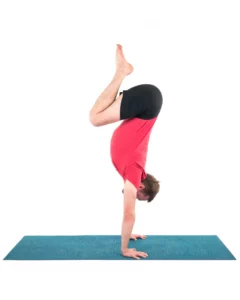4 Ways to Practice Locust Pose

Locust Pose (Salabhasana) is a simple backbend that strengthens the entire back of your body, from the nape of your neck to the backs of your heels. Salabhasana has benefits for a wide range of problems, including lower back pain, postural problems, and weakness anywhere along your back body, including your hips and hamstrings. And because the backbend is shallow and doesn’t put pressure on your wrists, it is accessible to almost everyone.
Locust Pose is Great for:
- lower back pain (it strengthens the muscles along the sides of your lower back)
- hamstring injuries
- arthritis of the knees (it strengthens the leg muscles)
- postural problems (such as excessive rounding and head-forward syndrome)
- arm strength (in the versions where you lift your arms)
- depression (for mild energizing when your energy is low)
- general weakness
Timing: For all versions, stay in the pose for 4-6 breaths, breathing comfortably. Then release and rest for a few breaths before repeating a second time. Gradually over time, work your way up to 12-16 breaths in the pose. You can also practice this pose dynamically, coming up into the backbend on your inhalation and releasing on your exhalation.
Cautions: Lifting too high or too quickly as you come into Salabhasana can trigger a cramp in the soles of your feet, hamstrings, or lower back. If this happens, try reducing the height and/or coming up more slowly. People with back pain should start with version 3 (one leg), and as you get stronger, gradually progress to the classic version. If you experience back pain in the pose, consult your teacher about your alignment before trying it again.
4 Variations of Locust Pose
1. Classic Locust Pose
 To come into the pose, start in a prone position with your arms by your sides and your forehead on the floor. Create a sense of length from your hips into both feet and from your tailbone up to the crown of your head.
To come into the pose, start in a prone position with your arms by your sides and your forehead on the floor. Create a sense of length from your hips into both feet and from your tailbone up to the crown of your head.- Then, keeping your pelvis and lower belly on the floor, inhale as you lift your chest, head, and legs a few inches off the floor and lift your arms parallel with the floor. Keeping your knees straight, reach your legs back as you reach forward through the crown of your head.
- To come out of the pose, exhale and release your legs, chest, head, and arms, returning to the starting position.
- Turn your head to one side and rest for a few breaths before repeating.
2. Locust Pose: Bolster Under Chest (Legs on the Floor)
 This version of Salabhasana is easier for people who are stiff and weak in the upper chest and is also a good option for focusing on chest opening.
This version of Salabhasana is easier for people who are stiff and weak in the upper chest and is also a good option for focusing on chest opening.
- Before coming into the pose, position the bolster crosswise at the level of your mid-breastbone and take your arms behind you alongside your torso.
- Then, inhale as you roll your head and chest up into a backbend position, lift your arms up to parallel to the floor or keep your hands on the floor, and widen your collarbones side to side. Keep your legs on the floor, but activate and lengthen them.
- To come out of the pose, exhale and release your chest, head, and arms and drape them over the bolster.
- Rest there for a few breaths before repeating.
3. Locust Pose: One Leg at a Time
This version of Salabhasana is helpful for those with back pain or sacrum problems, as it strengthens lower back muscles and can rebalance one-sided sacrum problems.
- After creating a sense of length in your starting position, keep your hips evenly aligned on the floor as you inhale and come into the pose.
- Roll your head and chest up a few inches and lift your arms up to parallel with the floor or keep them on the floor, and lift just your right leg up a few inches while continuing to lengthen both legs toward your toes.
- To come out of the pose, exhale and release your leg, chest, head, and arms, returning to the starting position.
- Rest for a few breaths before repeating on the left. Turn the head for this rest. Then repeat both sides once more.
4. Locust Pose: Legs Only
 Because your chest, head, and arms remain on the ground, this version of Salabhasana allows you to focus your work on strengthening your legs and buttocks. Having your hands on the floor provides more support, and may help you to get more lift in the legs.
Because your chest, head, and arms remain on the ground, this version of Salabhasana allows you to focus your work on strengthening your legs and buttocks. Having your hands on the floor provides more support, and may help you to get more lift in the legs.
- After creating a sense of length in your starting position, inhale as you lift your legs up a few inches while keeping your torso, arms and chin or forehead on the floor. Pressing your hands into the floor, attempt to swing the legs an inch or two higher.
- To come out of the Salabhasana, exhale and release your legs, returning to the starting position.
- Turn your head to one side and rest for a few breaths before repeating.
Also, read...
4 Ways to Practice Locust Pose
5 Keys to Healthy Neck Alignment in Cobra Pose (Bhujangasana)
Uttanasana: Expand Your Breath
Related courses
Breath as Medicine: Yogic Breathing for Vital Aging
Yoga and Myofascial Release: Releasing Chronic Tension with the Bodymind Ballwork Method

Baxter Bell, MD, C-IAYT, YACEP, fell in love with yoga in 1993 while he was working full-time as a family physician. His appreciation for the potential of yoga to foster health, healing, and equanimity was so great that he soon stepped down from his medical practice and trained to become a yoga teacher. Now, he focuses on teaching yoga full time, both to ordinary students of all ages and physical conditions and to the next generation of yoga teachers and yoga therapists, to whom he teaches anatomy and yoga therapy along with his accessible, skillful style of yoga. He also sees students privately, helping them use yoga to help heal from and/or cope with a wide range of medical conditions. At this point, with 23+ years of teaching experience under his belt, Baxter brings a unique perspective to his teaching, combining his understanding of anatomy and medicine with his skill at instructing people from all walks of life and all levels of ability.
In addition to teaching classes, workshops, and retreats internationally, Baxter is a past presenter at Yoga Journal Conferences and the International Association of Yoga Therapy’s Sytar Conference and teaches online courses and classes at Yoga U Online. Baxter is also the co-author of the popular and ground-breaking book Yoga for Healthy Aging and his blog, “What’s On Your (Yoga) Mind,” where he shares his knowledge of medical conditions, anatomy, yoga, and more with practitioners and teachers across the world. He has written articles for the Yoga Journal and the Journal of the International Association of Yoga Therapy. He is often quoted as an expert on yoga and health by major national news outlets such as the Washington Post and the Wall Street Journal. To learn more, visit www.baxterbell.com, and his YouTube channel and Instagram page at Baxter Bell Yoga.




